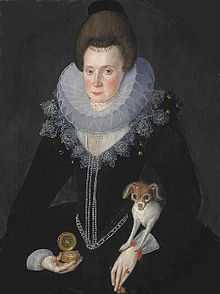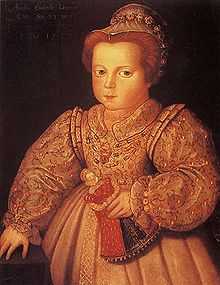Lady Arbella Stuart
| Lady Arbella Stuart | |
|---|---|
 Lady Arbella in her later years | |
| Born |
1575 Nottinghamshire or Hackney |
| Died |
27 September 1615 Tower of London |
Cause of death | Unspecified chronic illness and malnutrition |
| Nationality | English |
| Known for | Claimant to the English throne |
| Religion | Protestant |
| Spouse(s) | William Seymour, 2nd Duke of Somerset. |
| Parents |
Elizabeth Cavendish Charles Stuart, 1st Earl of Lennox |
Lady Arbella Stuart (or "Arabella" and/or "Stewart") (1575 – 25 September 1615) was a noblewoman who was for some time considered a possible successor to Queen Elizabeth I of England.
Born in England, Arbella Stuart was the only child of Charles Stuart, 1st Earl of Lennox, (of the third creation), and Elizabeth Cavendish. She was a grandchild of Matthew Stewart, 4th Earl of Lennox, (of the second creation), and Lady Margaret Douglas, who was, in turn, the daughter of Archibald Douglas, 6th Earl of Angus and Princess Margaret Tudor. Arbella was therefore a great great granddaughter of Henry VII of England and in line to the English throne – something to which she did not herself aspire.[1]
Her paternal grandparents, the 4th Earl of Lennox and Margaret Douglas, had two sons: Arbella's father Charles and his older brother, Henry Stuart, Lord Darnley, who became the second husband of Mary, Queen of Scots, and the father of Arbella's cousin James VI and I of Scotland, England and Ireland. Her maternal grandparents were Sir William Cavendish and Elizabeth Talbot, Countess of Shrewsbury, nowadays better known as "Bess of Hardwick".
In her final days, as a prisoner in the Tower of London, Lady Beauchamp (her married name), refusing to eat, fell ill, and died on 25 September 1615. She was buried in Westminster Abbey on 29 September 1615. In the 19th century, during a search for the tomb of James I, Arbella's lead coffin was found in the vault of Mary, Queen of Scots, placed directly on top of that of the Scots queen.[2]
Childhood

Arbella's father died in 1576 when she was still an infant. She was raised by her mother Elizabeth Cavendish until 1582.[3] The death of her mother left seven-year-old Arbella an orphan, whereupon she became the ward of her grandmother Bess, rather than Lord Burghley the Master of the Court of Wards, as might have been expected.[4]
During most of her childhood she lived in the protective isolation of Hardwick Hall in Derbyshire with her grandmother, who had married George Talbot, 6th Earl of Shrewsbury in 1568. There were, apparently, periodic visits to the court and to London, including court visits during the summers of 1587 and 1588 and one that lasted from November 1591 to July 1592.[5]
Starting in early 1589 or thereabouts "one Morley ... attended on Arbell and read to her", as reported in a dispatch from Bess of Hardwick to Lord Burghley, dated 21 September 1592.[6] Bess recounts Morley's service to Arbella over "the space of three years and a half". She also notes he had hoped for an annuity of some £40 a year from Arbella based on the fact that he had "been so much damnified [i.e. that much out of pocket] by leaving the University". This has led to speculation that Morley was the poet Christopher Marlowe,[7] whose name was sometimes spelled that way.
Heiress to the English throne
For some time before 1592, Arbella was considered one of the natural candidates to succeed her first cousin twice removed, Queen Elizabeth I.[8] However, between the end of 1592 and the spring of 1593, the influential Cecils – Elizabeth's Lord Treasurer, Lord Burghley, and his son, Secretary of State Sir Robert Cecil – turned their attention away from Arbella towards her cousin James VI of Scotland, regarding him as a preferable successor.[9]
She was at times invited to Elizabeth's court, but spent much of her time away with her grandmother. Continuing her education into her twenties, she studied several languages and could play the lute, viol and virginals.[10]
In 1603, after James's accession as James I of England, those involved in the Main Plot allegedly conspired to overthrow him and put Arbella on the throne. When she was invited to participate by agreeing in writing to Philip III of Spain, however, she immediately reported it to the authorities.[11]
Marriage negotiations
Owing to Arbella's status as a possible heir to the throne, there were discussions of appropriate marriages for her throughout her childhood. It would have suited the Roman Catholic Church for her to marry a member of the House of Savoy and then take the English throne. A marriage was also mooted with Ranuccio, eldest son of Alexander Farnese, Duke of Parma and Maria of Portugal.[6] According to the Curiosities of Literature by Isaac D'Israeli,[12] this scheme originated with the Pope, who eventually settled on his own brother, a cardinal, as a suitable husband for Arbella. The Pope defrocked his brother, freeing him to marry "Arbelle" (as the Italians spelled her name) and thus claim the English crown. Nothing came of this plan, and in fact the only direct evidence of Arbella's religion is her taking Protestant communions while at Shrewsbury House in Chelsea.[13]
In the closing months of Elizabeth's reign, Arbella fell into trouble through reports that she intended to marry Edward Seymour, a member of the prominent Seymour family. This was reported to the Queen by the supposed groom's grandfather, Edward Seymour, 1st Earl of Hertford. Arbella denied having any intention of marrying without the Queen's permission, which was required for any marriage to be legal.
In 1588, it was proposed to James VI of Scotland that Ludovic Stuart, 2nd Duke of Lennox, should be married to Arbella, but nothing seems to have come of this suggestion either.[14] In 1604, Sigismund III Vasa, King of Poland, sent an ambassador to England to ask for Arbella to be his wife. This offer was rejected.[15]
Marriage to William Seymour

In 1610, Arbella, who was fourth in line to the English throne, was in trouble again for planning to marry William Seymour, then known as Lord Beauchamp, who later succeeded as 2nd Duke of Somerset. William Seymour was sixth-in-line, grandson of Lady Catherine Grey, a younger sister of Lady Jane Grey and a granddaughter of Mary Tudor, younger sister of King Henry VIII and Arbella's ancestor, Margaret Tudor.
Although the couple at first denied that any arrangement existed between them, they later married in secret on 22 June 1610 at Greenwich Palace. For marrying without his permission, King James imprisoned them: Arbella in Sir Thomas Perry's house in Lambeth and Seymour in the Tower of London. The couple had some liberty within those buildings, and some of Arbella's letters to Seymour and to the King during this period survive. When the King learned of her letters to Seymour, however, he ordered Arbella's transfer to the custody of William James, Bishop of Durham. Arbella claimed to be ill, so her departure for Durham was delayed.
The couple used that delay to plan their escape. Arbella dressed as a man and escaped to Lee (in Kent), but Seymour did not meet her there before their getaway ship was to sail for France. Sara Jayne Steen records that Imogen, the virtuous, cross-dressed heroine of William Shakespeare's play Cymbeline (1610–1611) has sometimes been read as a reference to Arbella.[16]
Seymour did escape from the Tower, but by the time he reached Lee, Arbella was gone, so he caught the next ship to Flanders. Arbella's ship was overtaken by King James's men just before it reached Calais, France. She was returned to England and imprisoned in the Tower of London. She never saw her husband again and died in the Tower on 25 September 1615 from illnesses exacerbated by her refusal to eat.
It is said that the couple may have had a child, Mary. This cannot be confirmed or denied since it's believed that Arabella died with no issue, but the birth would have been in secret since it would have angered the King even more than the marriage already had.
Literary legacy
Over one hundred letters written by Arbella have survived. In 1993, a collection of them was published, edited by Sara Jayne Steen, providing details of her activities and ideas.
The English novelist and historical biographer Doris Leslie, wrote 'Wreath for Arabella' in 1948.
Aemilia Lanier's poem Salve Deus Rex Judaeorum is dedicated to Arbella. Lanier recalls a former personal friendship with Arbella that was unrequited; she addresses her as "Great learned Ladie ... whom long I have known "but not known so much as I desired".
Felicia Hemans' poem Arabella Stuart is about Arbella, imagining her thoughts as she died in prison.
Family tree
Ancestry
| Ancestors of Lady Arbella Stuart | |||||||||||||||||||||||||||||||||||||||||||||||||||||||||||||||||||||||||||||||||||||||||||||||||||||||||||||||||||||||||||||||||||||||||||||||||||||||||||||||||||||||||||||||||||||||||||||||||||||||||||||||||||||||||||||||||||||||||||||||||||||||||||||||||||||||||||||||||||||||||||||||||||||||||||||||||||||||||||||||||||||||||||||||||||||||||||||||||||||||||||||||||||||||||||||||||||||||||||||||||||||||||||||||||||||||||||||||||||||||||||||||||||||||||||||||||||||||||||||||||||||||||||||||||||||||||||||||||
|---|---|---|---|---|---|---|---|---|---|---|---|---|---|---|---|---|---|---|---|---|---|---|---|---|---|---|---|---|---|---|---|---|---|---|---|---|---|---|---|---|---|---|---|---|---|---|---|---|---|---|---|---|---|---|---|---|---|---|---|---|---|---|---|---|---|---|---|---|---|---|---|---|---|---|---|---|---|---|---|---|---|---|---|---|---|---|---|---|---|---|---|---|---|---|---|---|---|---|---|---|---|---|---|---|---|---|---|---|---|---|---|---|---|---|---|---|---|---|---|---|---|---|---|---|---|---|---|---|---|---|---|---|---|---|---|---|---|---|---|---|---|---|---|---|---|---|---|---|---|---|---|---|---|---|---|---|---|---|---|---|---|---|---|---|---|---|---|---|---|---|---|---|---|---|---|---|---|---|---|---|---|---|---|---|---|---|---|---|---|---|---|---|---|---|---|---|---|---|---|---|---|---|---|---|---|---|---|---|---|---|---|---|---|---|---|---|---|---|---|---|---|---|---|---|---|---|---|---|---|---|---|---|---|---|---|---|---|---|---|---|---|---|---|---|---|---|---|---|---|---|---|---|---|---|---|---|---|---|---|---|---|---|---|---|---|---|---|---|---|---|---|---|---|---|---|---|---|---|---|---|---|---|---|---|---|---|---|---|---|---|---|---|---|---|---|---|---|---|---|---|---|---|---|---|---|---|---|---|---|---|---|---|---|---|---|---|---|---|---|---|---|---|---|---|---|---|---|---|---|---|---|---|---|---|---|---|---|---|---|---|---|---|---|---|---|---|---|---|---|---|---|---|---|---|---|---|---|---|---|---|---|---|---|---|---|---|---|---|---|---|---|---|---|---|---|---|---|---|---|---|---|---|---|---|---|---|---|---|---|---|---|---|---|---|---|---|---|---|---|---|---|---|---|---|---|---|---|---|---|---|---|---|---|---|---|---|---|---|---|---|---|---|---|---|---|---|---|---|---|---|---|---|---|---|---|---|---|---|---|---|---|---|---|---|---|---|---|---|---|---|---|---|---|---|---|---|---|---|---|---|---|---|---|---|---|---|---|---|---|---|---|---|---|---|---|---|---|---|---|---|---|---|---|---|---|---|---|---|---|---|---|---|---|---|---|---|---|---|---|---|---|---|---|---|---|---|---|---|---|---|---|---|---|
| |||||||||||||||||||||||||||||||||||||||||||||||||||||||||||||||||||||||||||||||||||||||||||||||||||||||||||||||||||||||||||||||||||||||||||||||||||||||||||||||||||||||||||||||||||||||||||||||||||||||||||||||||||||||||||||||||||||||||||||||||||||||||||||||||||||||||||||||||||||||||||||||||||||||||||||||||||||||||||||||||||||||||||||||||||||||||||||||||||||||||||||||||||||||||||||||||||||||||||||||||||||||||||||||||||||||||||||||||||||||||||||||||||||||||||||||||||||||||||||||||||||||||||||||||||||||||||||||||
Bibliography
- Blanche Christabel Hardy, Arbella Stuart: a biography (1913)
- P. M. Handover, Arbella Stuart: Royal Lady of Hardwick (1957)
- David N. Durant, Arbella Stuart: a Rival to the Queen (1978)
- Conyers Read, Lord Burghley and Queen Elizabeth (1960)
- Sarah Jayne Steen, ed., The Letters of Lady Arbella Stuart (1994)
- Sarah Gristwood, Arbella: England's lost queen (2003)
Notes
- ↑ Rosalind K. Marshall, Stuart , Lady Arabella (1575–1615), Oxford Dictionary of National Biography, Oxford University Press, 2004 [http://www.oxforddnb.com/view/article/601, accessed 3 March 2008]
- ↑ Stanley, Arthur (1886). Westminster Abbey. London: John Murray. p. 499.
- ↑ Antonia Fraser, Mary, Queen of Scots, p. 535
- ↑ Sarah Gristwood, Arbella: England's Lost Queen, Bantam, 2003, p.49
- ↑ David N. Durant, Arbella Stuart: A Rival to the Queen, 1978, pp.41, 51, 61
- ↑ 6.0 6.1 Blanche C. Hardy, Arbella Stuart: A Biography, Dutton, 1913, pp.64–67
- ↑ Charles Nicholl, The Reckoning: The Murder of Christopher Marlowe, 1992, pp.340–342
- ↑ Marshall, p.601
- ↑ Handover, The Second Cecil, 55-6; 297; Read, Lord Burghley, 484
- ↑ Lovell, Mary S. (2005). Bess of Hardwick, First Lady of Chatsworth. Little, Brown. pp. 408–409.
- ↑ Gristwood, pp.267–269
- ↑ D'Israeli, Isaac (1824). A second series of Curiosities of literature, Vol.I. J. Murray. p. 258.
- ↑ Gristwood, pp.128–129
- ↑ Gristwood, p.109
- ↑ Gristwood, pp.301–302
- ↑ Steen, 96
References
- Marshall, Rosalind. "Arabella Stuart." Dictionary of National Biography. Oxford: Oxford University Press, 2004.